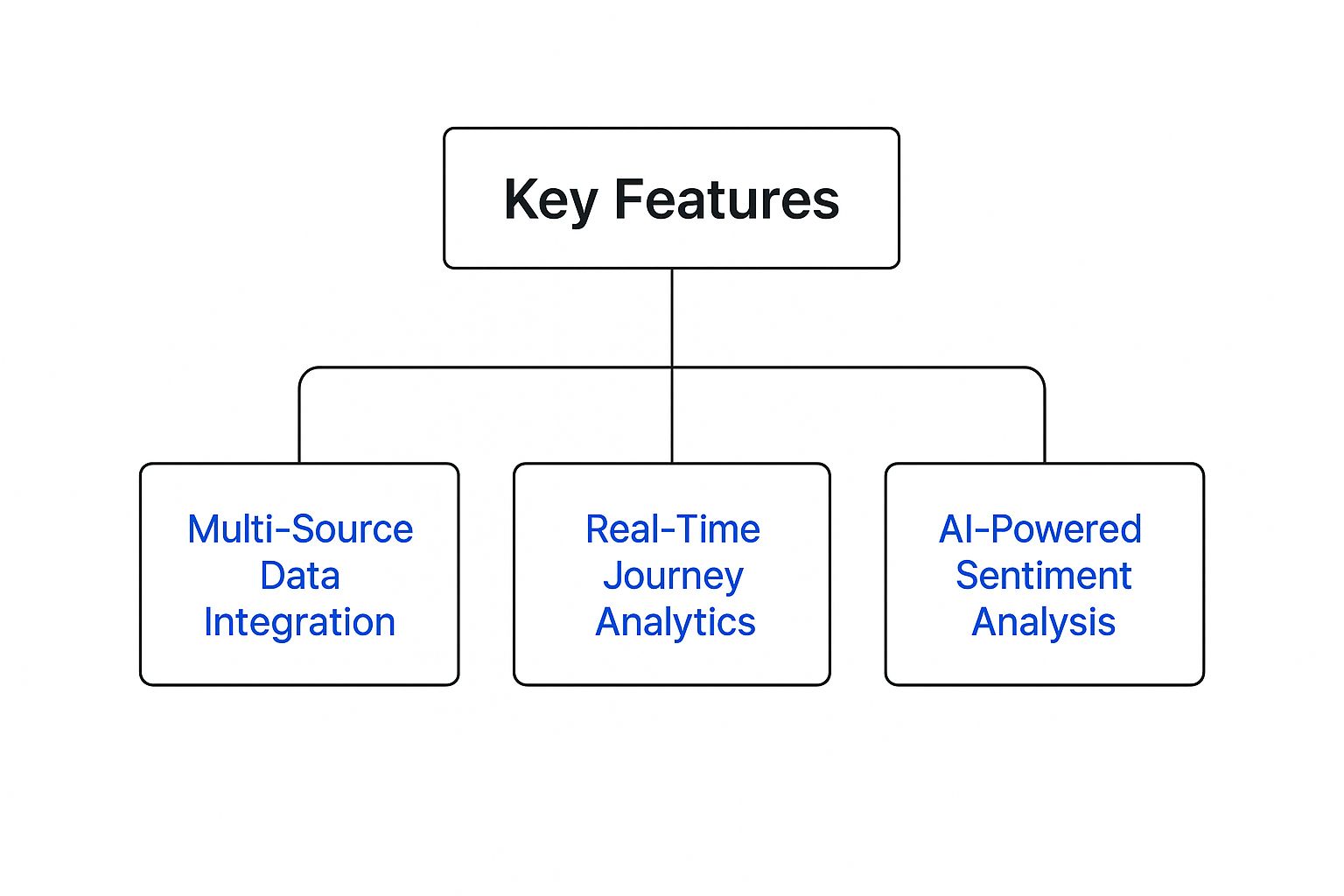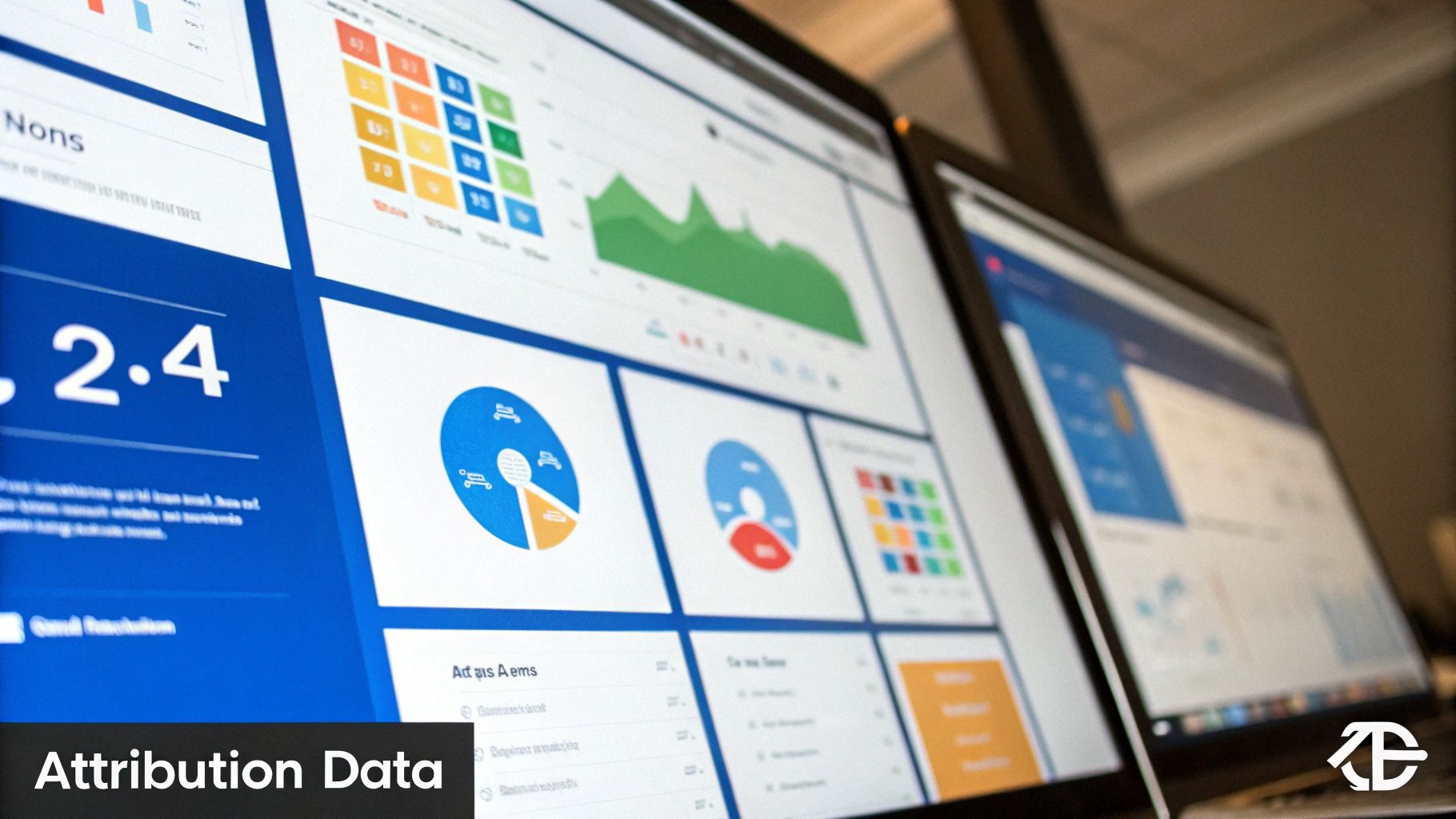Think of customer journey mapping software as the ultimate tool for seeing your business through your customers' eyes. It’s designed to visually lay out every single interaction someone has with your brand, transforming a messy pile of data points into a clear, actionable roadmap. With it, businesses can finally understand the customer experience, pinpoint exactly where things go wrong, and uncover hidden opportunities to make things better.

Imagine your customer's experience is a road trip. Some parts are smooth sailing on a scenic highway, while others are frustrating detours and unexpected traffic jams. Without a map, you have no clue where they're getting stuck or why they might ditch the trip entirely.
This is why understanding the customer journey isn't just a "nice-to-have" anymore. It's essential for survival.
In the past, the path from seeing an ad to making a purchase was pretty straightforward. A customer might see a TV commercial, visit your store, and buy something. Simple. Today, that linear road has exploded into a complex web of digital and physical touchpoints.
A single customer journey can now involve dozens of interactions across a dizzying number of channels. A potential buyer might first see your brand in a social media ad, then read a few reviews on a third-party site, visit your website on their laptop, add an item to their cart, and finally complete the purchase on their phone three days later.
Each of those steps is a critical moment that shapes their opinion of you. If you don't have a clear view of this entire process, you're flying blind. You could be pouring money into one channel while a major roadblock in another is quietly killing your conversions.
"A customer journey map is a visual overview of the experiences consumers have when interacting with a company. With these maps, you can see where you’re succeeding in your acquisition efforts and where you’re losing customers."
This complexity is precisely where customer journey mapping software becomes so valuable. These platforms connect the dots between all those scattered interactions, helping you visualize the entire, often chaotic, customer experience from start to finish.
The massive growth in this software category tells you everything you need to know. The global customer journey mapping software market is projected to hit $16.46 billion in 2025, a huge jump from $14.2 billion in 2024. That 15.9% year-over-year increase signals that businesses are scrambling to adopt these tools for a competitive edge.
By mapping the journey, you finally get answers to mission-critical questions:
Answering these lets you stop making assumptions and start making data-backed decisions that genuinely improve customer satisfaction and drive revenue. To dig deeper into the fundamentals, check out our guide to effectively track the customer journey.
Because in the end, mapping isn't just about drawing a pretty diagram. It's about building a strategic tool that guides every single customer-facing decision your business makes.
Let's cut through the jargon. At its core, customer journey mapping software is a visual storyteller for your business.
Imagine trying to understand a complex story by looking at a handful of random, disconnected photos. One photo shows a website visit, another is a support ticket, and a third is a random social media comment. It’s impossible to see the whole narrative.
This is the exact problem most businesses face. Your customer data is scattered everywhere—in your website analytics, CRM, sales notes, and support logs. By itself, it’s just a collection of isolated events.
Customer journey mapping software plays the role of the director. It pulls all those scattered data points together and weaves them into a single, coherent, visual story. This narrative shows you the complete experience a customer has with your brand, from their very first interaction to their most recent purchase and beyond. It creates a living map that shows precisely where customers are delighted, where they get stuck, and where they ultimately fall off.
The real power of this software is its ability to turn abstract numbers into something your team can actually understand and act on. Instead of just knowing that 20% of users abandon their shopping carts, you can see the specific sequence of clicks, hesitations, and error messages that led to that outcome.
This transformation happens through a few key functions:
This level of detail is what separates smart business decisions from blind guesses. It's the difference between knowing your roof is leaking and having a blueprint that shows you exactly which pipe is broken and how to fix it. Similarly, knowing the difference between a journey map and an experience map can provide additional clarity; you can learn more about journey maps vs. experience maps in our detailed guide.
Think of the software as a sophisticated GPS for your customer's experience. It doesn’t just show the final destination (like a sale); it tracks every turn, stop, and detour they take along the way. This visual representation is what makes the information so powerful.
Your teams can literally see the customer's path unfold. A product manager might notice users repeatedly clicking a non-functional button, signaling a clear UX problem. A marketing manager might see that customers who watch a specific video tutorial are 50% more likely to convert.
These visual insights are what drive real improvement. They eliminate guesswork and allow different departments—marketing, sales, product, and support—to rally around a shared, accurate understanding of what the customer is actually going through.
The goal is to move from assumptions to facts. A well-built journey map, powered by robust software, provides a single source of truth that aligns the entire organization around the customer’s actual experience.
The growing importance of this technology is clear when you look at the numbers. The customer journey analytics market is projected to be worth $20.87 billion in 2025, expanding at an impressive 18.32% CAGR. This growth is overwhelmingly driven by cloud-based solutions, which held a 61.4% market share in 2024 because they provide the power needed for real-time analysis. Discover more insights about customer journey analytics trends. It's proof that businesses are investing heavily in turning their complex data into a clear roadmap for success.
Picking the right customer journey mapping software can feel like navigating a maze. Dozens of platforms flash shiny dashboards and promise a perfect, 360-degree view of your customer. But here’s the thing: not all tools are built the same.
The real difference isn't in the visuals; it's in the engine running underneath. A basic tool gives you a static diagram—a pretty picture. A strategic powerhouse, on the other hand, turns that picture into live, actionable intelligence. You need to look past the surface and zero in on the core features that actually drive business results. Think of it as choosing between a paper road map and a live GPS that reroutes you around traffic in real time.
Let's be honest, your customer data is probably all over the place. It’s in your CRM, your website analytics, your email platform, your help desk software—you name it. A non-negotiable feature for any serious journey mapping tool is the ability to pull all those scattered pieces together into one coherent story.
Multi-source data integration is what separates a map based on assumptions from one grounded in reality. Without it, you’re just looking at disconnected snapshots.
When you bring all this data together, your map becomes the single source of truth. Suddenly, marketing, sales, and support are all looking at the same customer, breaking down silos and building a truly customer-focused culture.
This hierarchy diagram illustrates how foundational features transform raw data into strategic insight within a modern journey mapping platform.

As you can see, it all starts with data integration. That raw data feeds into real-time analytics and deeper AI analysis, ultimately giving you a complete, nuanced understanding of the customer experience.
Customer behavior changes in the blink of an eye, so why should your journey map be stuck in the past? The best platforms offer real-time journey analytics, giving you a live look at how customers are moving through their paths right now, not three months ago.
This is a complete game-changer. Instead of reacting to last quarter's report, your team can spot and fix problems as they happen. Imagine seeing a sudden spike in cart abandonment on your e-commerce site. With real-time data, you can investigate immediately, find the broken checkout button, and fix it before it costs you thousands more in lost sales. To dive deeper into this topic, explore our complete guide on the power of customer journey analytics.
Real-time data turns your journey map from a historical document into a living, breathing operational tool. It enables agility, allowing you to respond to customer needs and market shifts with speed and precision.
A journey map collecting dust on someone’s desktop is useless. Its true power is unleashed when it becomes a shared resource for the entire company. Look for a collaborative mapping canvas that lets people from marketing, product, sales, and support all work together in the same space.
Think of it like a massive digital whiteboard where everyone can add their expertise. A salesperson can drop a note about a common objection they hear on demos. A support agent can flag a recurring complaint from user tickets. This shared environment ensures the map reflects the whole customer reality, not just one department's limited view, fostering a collective ownership of the customer experience.
Knowing what a customer does is one thing. Understanding why they do it—and how they feel—is the key to building loyalty. Modern customer journey mapping software is increasingly using AI-powered sentiment analysis to tap into the emotional side of the experience.
These tools can scan language from reviews, surveys, support chats, and social media, automatically tagging interactions as positive, negative, or neutral. This adds a powerful emotional layer to your map, instantly highlighting moments of frustration that need fixing and moments of delight you should be amplifying. It’s how you move from just mapping a process to truly empathizing with your customers.

It’s one thing to know what customer journey mapping software does, but it’s another to see how it can completely reframe your business strategy. These platforms are more than just fancy flowchart tools. They become a lens that reveals massive opportunities you never knew were hiding in your customer data, turning abstract metrics into real, tangible wins.
Think about an e-commerce brand seeing high cart abandonment rates. Without a map, they’re left guessing. Is it the price? Shipping costs? Maybe. But with a journey map, they can see the exact sequence of events. They might discover that mobile users are constantly failing to apply a popular discount code, getting frustrated, and bouncing.
By pinpointing that specific bottleneck, the brand can fix the bug and simplify the coupon field. The result? A 30% reduction in cart abandonment in just one quarter. That’s the strategic power of mapping in action. It doesn’t just show you what is happening; it tells you why.
You can’t build a customer-centric business on spreadsheets alone. True empathy comes from understanding the human story behind the numbers, and that's exactly what a journey map provides. It bridges the gap between raw data and lived experience.
Instead of just seeing a churn statistic, you see the frustrating path a customer actually took—a slow-loading page, a confusing support article, and an unanswered email. This kind of visceral understanding gets your whole team, from product to marketing, aligned around one simple goal: making the customer's life easier.
This shift from numbers to narratives has a huge impact on company culture. It builds a foundation of empathy that informs every decision, making sure the customer’s voice is always in the room.
Guesswork is expensive. Every decision you make based on a hunch instead of hard evidence is a roll of the dice with your time, budget, and resources. Customer journey mapping software takes "we think" and turns it into "we know."
It gives you a clear, evidence-based view of what’s working and what isn’t. For instance, a SaaS company might believe their detailed onboarding emails are the key to user activation. But a journey map could reveal that most new users skip the emails entirely and head straight for a short in-app video tutorial.
Armed with that insight, they can stop pouring resources into long emails and start producing more of the high-impact video content that actually moves the needle—all based on real user behavior.
A journey map isn't just a visualization; it's a strategic compass. It points your teams toward the highest-impact opportunities for improvement, ensuring every investment is aimed at solving a real, validated customer problem.
We’ve all heard it: acquiring a new customer can be up to five times more expensive than keeping an existing one. Journey mapping is one of the best tools for retention because it helps you proactively spot and fix the friction points that cause people to leave.
By layering in emotional journey mapping—tracking feelings, not just actions—you get an even more powerful view. This is critical in a market where 49% of U.S. customers say they’ve switched brands after just one poor experience. It’s no surprise that the customer journey mapping software market is projected to hit an incredible $76.2 billion by 2035, driven by this need to understand customer emotions to build lasting loyalty. You can dig into the full analysis of the customer journey mapping software market on Future Market Insights.
Finally, a clear view of the customer journey puts a spotlight on your own internal inefficiencies. When different departments are stuck in their silos, the customer experience often becomes fragmented and frustrating.
A journey map brings these disconnects into the open.
By exposing these cross-departmental friction points, the software helps you streamline workflows, improve communication, and build a cohesive internal process that delivers a much better customer experience.
Creating a detailed customer journey map is a huge win, but its real value isn't in the document itself. A map is useless without a destination, and a journey map only becomes powerful when you use it to drive meaningful change. The goal isn't just to visualize the path; it's to improve it.
This is where you transform those hard-won insights into concrete, strategic actions. Too many businesses build beautiful, data-rich maps only to let them gather digital dust. To avoid that fate, you need a clear playbook for turning your mapping effort into a dynamic, results-oriented initiative that guides your entire organization.
The first step? Treat your journey map not as a finished project, but as the starting line.
Before you try to fix everything at once, you have to define what success actually looks like. Your map will likely uncover dozens of potential improvements, from minor website tweaks to major process overhauls. Without clear objectives, you'll struggle to prioritize, and your efforts will feel scattered and ineffective.
Your goals need to be specific, measurable, and tied directly to a business outcome. Don't just aim to "improve the customer experience." Instead, set a goal like, "reduce checkout abandonment by 15% in the next quarter by simplifying the payment process." That's a target you can hit.
Here are a few examples of strong, action-oriented objectives:
Setting these targets gives your team a clear destination and a way to measure progress, ensuring your journey mapping initiative delivers a tangible return.
A customer journey isn't owned by a single department. It’s a shared experience that touches marketing, sales, product, and support. Because of that, putting your map into action requires a dedicated, cross-functional team to champion the necessary changes.
This "journey team" should include representatives from each key department that interacts with the customer. Their role is to analyze the map's findings from their unique perspective and collaborate on solutions that work for everyone.
A journey map becomes a powerful catalyst for change when it serves as a shared language for different teams. It breaks down organizational silos and rallies everyone around a single, unified view of the customer's reality.
For instance, if the map reveals that marketing is promising a feature that the product doesn't fully deliver, both teams need to be in the room to align messaging and product development. This collaborative approach ensures that solutions are holistic and don't inadvertently create new problems elsewhere in the journey.
With your objectives set and your team assembled, it's time to dig into the map and turn insights into an actionable backlog. Host a workshop where your team walks through the journey map stage by stage, identifying key pain points and opportunities.
For each issue you find, ask three critical questions:
This analysis will help you prioritize. Focus on the high-impact, low-effort fixes first—the "quick wins" that can build momentum and prove the value of your journey mapping efforts. From there, you can tackle the larger, more complex projects that promise significant long-term returns.
For more advanced strategies, explore our guide on customer journey optimization to refine your approach. Remember, a journey map is a living tool that should evolve with your business and your customers.

Any good customer journey mapping software needs one thing to work its magic: clean, accurate, and complete data. If your map is built on assumptions or spotty information, it's like a road map with half the streets missing. You’re not going to get where you need to go. This is especially true when you're trying to figure out how your ads actually shape the customer experience.
Understanding the journey starts with understanding every single touchpoint, and that’s where attribution comes in. Cometly acts as the foundational data layer for your entire mapping strategy. It provides the rock-solid attribution you need to build maps that reflect reality, not guesswork. It’s built to track a customer's full path through even the most complex ad funnels, giving you a clear, undeniable picture of what’s driving results.
Without that level of clarity, your journey map might tell you a customer converted after visiting your site, but it won’t reveal they first saw your brand from a specific TikTok ad three days earlier.
Cometly doesn’t just gather data; it connects the dots between what a customer does and where you spend your ad dollars. It meticulously tracks interactions across every channel, campaign, and creative, showing you exactly how each touchpoint nudges someone closer to a conversion.
This is all made possible through powerful attribution models that give credit where it's actually due.
When you use both models, you get the full story of what’s working at the beginning, middle, and end of the journey. This lets you build far more accurate and genuinely useful maps.
A journey map powered by precise attribution data is more than just a visual aid—it's a strategic tool for optimizing ad spend. It ensures you invest in the channels that deliver real value at every stage of the customer experience.
Imagine this: a potential customer sees your ad on Facebook, clicks it, but doesn't buy. A week later, they get a retargeting ad on Google, click again, and finally make a purchase. Cometly’s platform captures that entire sequence, making sure your journey map reflects the complete, multi-channel reality of modern advertising.
This granular tracking lets you move past surface-level metrics and truly understand the ROI of your campaigns. You can see exactly how different ad platforms work together to guide a customer toward a sale, letting you optimize your budget for a seamless and effective experience from the very first click.
To see this in action, you can explore the powerful features of Cometly’s analytics and attribution platform.
Even with a killer strategy, pulling the trigger on customer journey mapping software can feel like a big leap. It's totally normal for practical questions to pop up.
Think of this as your quick-start guide to clearing the most common hurdles—getting the green light from your boss, figuring out if you need a PhD to use the software, and proving it was all worth it in the end.
Here’s the secret: stop talking about the software. Seriously. Leadership doesn't care about drag-and-drop features; they care about outcomes.
Frame your pitch around solving expensive problems. Are churn rates too high? Are conversion rates tanking? Point to the pain, then present journey mapping as the tool to diagnose and fix it. Come armed with data. Show them the ugly numbers—cart abandonment, support ticket volume, whatever is keeping them up at night. Position the software as a direct investment in plugging those leaks and boosting the bottom line.
A strong business case isn't about the map itself. It's about the revenue opportunities and cost savings the map will uncover. You're not buying software; you're investing in efficiency and customer retention.
Honestly, it varies. But the good news is that modern platforms are built for marketers and product managers, not data scientists. Most of the top customer journey mapping software options have intuitive, drag-and-drop interfaces and come loaded with templates. If you can build a presentation slide or a simple flowchart, you've got the skills to create a basic journey map.
The trickier part can be integrating all your data sources. While many tools offer simple one-click connections to your CRM or analytics platforms, a more custom setup might require a little help from your IT team to get everything talking to each other. But for day-to-day use? It’s usually pretty straightforward.
Measuring the return on investment (ROI) comes down to connecting your mapping efforts to cold, hard numbers—your key performance indicators (KPIs). Before you change a single thing, you need to establish a baseline for the metrics you want to move.
Once you’ve used your map to spot a problem and implement a fix, track the "before and after" for things like:
When you can draw a straight line from a change you made on the map to a real business outcome, you've got a clear, quantifiable ROI.
Ready to build journey maps based on rock-solid attribution data? Cometly provides the foundational layer you need to see the full customer story, from the first ad click to the final conversion.
Learn how Cometly can help you pinpoint channels driving revenue.
.svg)
Network with the top performance marketers in the industry